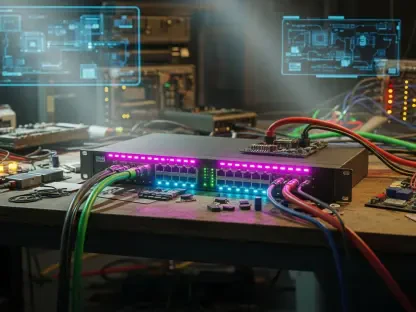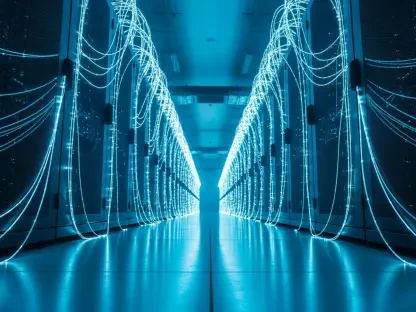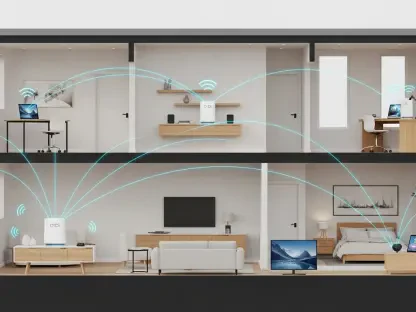In a chilling reminder of the ever-looming dangers in the digital landscape, a sophisticated cybercriminal group known as Akira has emerged as a formidable threat, targeting corporate networks through vulnerabilities in SonicWall VPNs with alarming speed and precision. Recent reports reveal that this ransomware gang has honed its tactics to exploit weak login credentials, often encrypting critical data within an hour of gaining access. This rapid-fire approach leaves organizations with virtually no time to react, amplifying the devastation of their attacks. As businesses increasingly rely on remote access tools for operational continuity, the exploitation of such systems underscores a critical vulnerability in modern cybersecurity frameworks. The urgency to understand and counter this threat has never been greater, as financial losses mount and the scale of impacted entities continues to grow.
Emerging Threats in Cybersecurity
Exploiting Weak Points in Remote Access
The primary method employed by the Akira ransomware group involves targeting SonicWall SSL VPN accounts, particularly those without multi-factor authentication (MFA) in place. Attackers utilize brute-force techniques to crack weak passwords, gaining entry into corporate networks with alarming efficiency. Once inside, they disable security tools and deploy ransomware, often completing the encryption process in under 60 minutes. This “smash and grab” strategy minimizes the window for detection and response, making it a particularly insidious threat. Tools like AnyDesk for remote control and Mimikatz for credential harvesting further enable swift lateral movement across networks, compromising sensitive data before defenses can be mobilized. The focus on remote access points highlights a recurring pattern among cybercriminals, exploiting systems that are essential for business operations yet often inadequately secured.
Patterns of Rapid Deployment and Damage
Beyond the initial breach, the speed at which Akira operates sets it apart from many other ransomware groups. Reports indicate that within moments of accessing a network, attackers exfiltrate critical data while simultaneously preparing to lock systems with encryption. This dual approach maximizes both financial leverage through ransom demands and operational disruption for the targeted organization. The use of living-off-the-land binaries—legitimate system tools repurposed for malicious intent—allows attackers to blend into normal network traffic, evading traditional detection methods. Additionally, custom scripts automate much of the attack process, showcasing a level of sophistication that challenges even well-prepared defenses. The financial toll is staggering, with estimates suggesting millions in losses from hundreds of victims globally, emphasizing the urgent need for enhanced protective measures against such fast-moving threats.
Strategies for Defense and Mitigation
Strengthening Authentication and Monitoring
To combat the relentless attacks by groups like Akira, cybersecurity experts advocate for immediate and robust defensive strategies, starting with the enforcement of multi-factor authentication across all VPN accounts. This additional layer of security significantly hampers brute-force attempts, as attackers must overcome more than just a password to gain entry. Alongside MFA, continuous monitoring for anomalous login activity is crucial, enabling organizations to detect potential breaches before they escalate. Regular audits of VPN configurations can also identify vulnerabilities, while network segmentation limits the ability of attackers to move laterally if a breach occurs. These proactive steps, though resource-intensive, are essential in an era where ransomware groups exploit even the smallest oversight with devastating consequences, requiring a shift from reactive to preventive security postures.
Adapting to Evolving Attack Techniques
As ransomware tactics evolve, so too must the strategies to counter them, particularly in light of Akira’s ability to manipulate Windows event logs and deploy variants resistant to common decryption tools. Investing in AI-driven anomaly detection systems offers a promising avenue, as these tools can identify subtle deviations in network behavior that might indicate an attack in progress. Regular penetration testing is another vital measure, simulating real-world attacks to uncover weaknesses before malicious actors do. Collaboration across the industry also plays a key role, with initiatives like endpoint containment showing success in disrupting ransomware operations in the past. Staying ahead of sophisticated evasion techniques, such as those targeting endpoint detection and response systems, demands constant vigilance and adaptation, ensuring that defenses remain dynamic in the face of relentless innovation by cybercriminals.
Building a Resilient Security Framework
Looking back, the battle against Akira ransomware revealed a critical lesson: complacency in cybersecurity was a luxury organizations could no longer afford. The rapid encryption and data exfiltration tactics employed by this group exposed systemic vulnerabilities in remote access tools, prompting a reevaluation of security protocols worldwide. Reflecting on past responses, the emphasis on mandatory patching and layered authentication proved to be a turning point for many affected entities. Moving forward, the focus shifted to actionable solutions, such as integrating advanced threat intelligence and fostering cross-industry partnerships to anticipate and neutralize emerging threats. The journey to resilience required sustained investment in cutting-edge technologies and a commitment to regular training for IT teams, ensuring that the lessons learned from Akira’s devastating campaigns continued to inform stronger, more adaptive defenses against future cyber threats.









